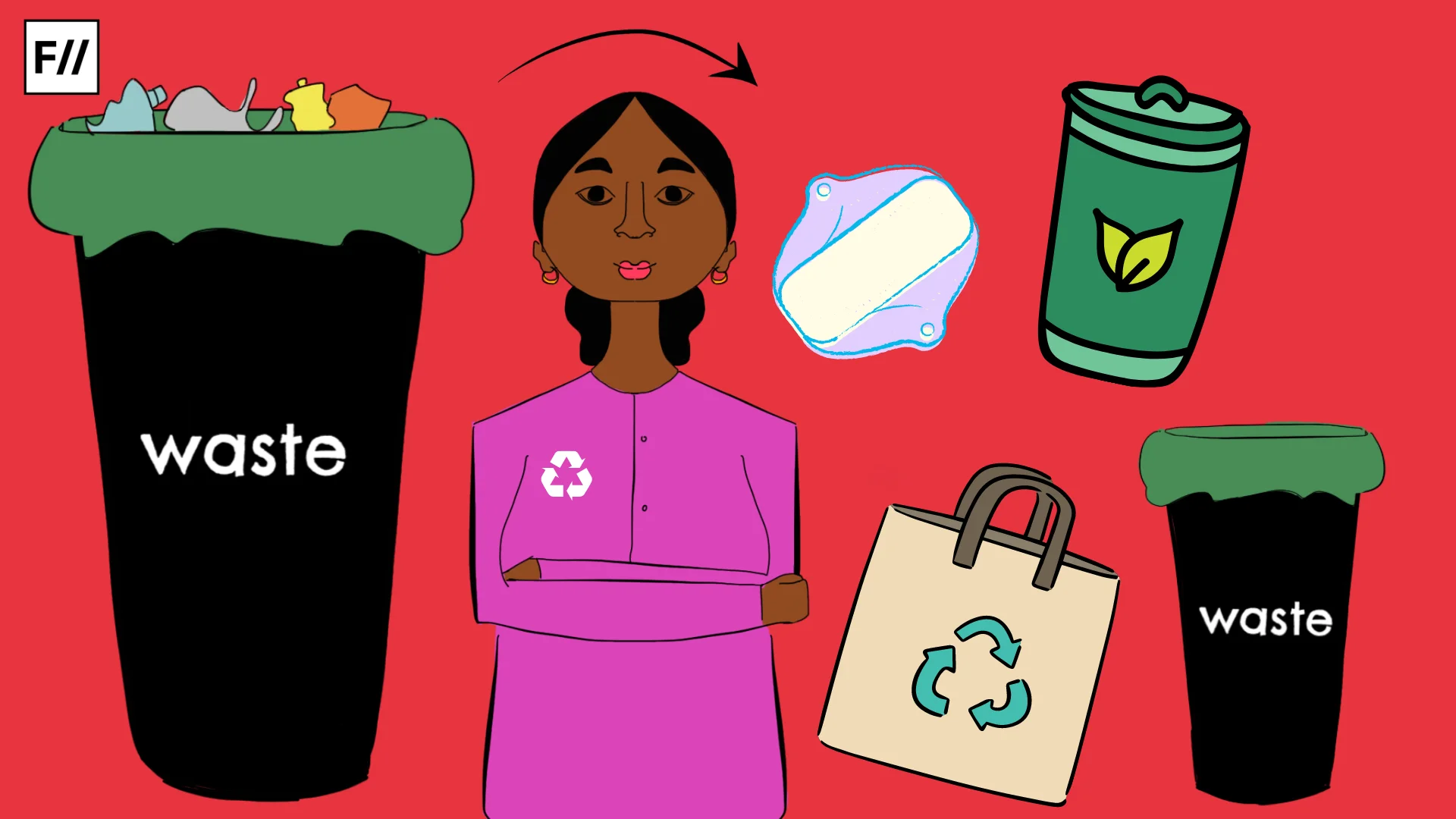 Editor’s note: Approx 125kg of sanitary waste is generated per person during their menstruating years and these sanitary napkins can take 500-800 years to break down! #ThePadEffect is a campaign to advocate for sustainable menstruation and prevent thousands of tons of sanitary waste.
Editor’s note: Approx 125kg of sanitary waste is generated per person during their menstruating years and these sanitary napkins can take 500-800 years to break down! #ThePadEffect is a campaign to advocate for sustainable menstruation and prevent thousands of tons of sanitary waste.Posted by Rajasi Kulkarni
Menstruation, a topic discussed in hushed voices and kept private amongst girls/women and their groups, is not talked about out in the public. Pads are bought fugitively, discreetly packed, quietly used and secretly thrown away in public washrooms, buried or burned in backyards or open fields, or simply dumped in a dustbin.
Once thrown, they are not our responsibility. But after all this precaution, they still become an open secret as we see and smell them while walking on streets or in dumping grounds. There is no recycling mechanism and they end up in landfills where they don’t biodegrade thereby polluting the soil for decades.
In exchange for convenience, disposable sanitary pads make us pollute air, water and soil to an extreme extent. The cottony soft pads don’t contain cotton, but super-absorbent polymers mixed with bleached cellulose or synthetic pulp. These polymers are generally sodium salts of polyacrylic acid, capable of absorbing water up to 30 times its weight (i.e., 1g of sodium-polyacrylate can absorb 30 ml water). They can absorb all the water in a drain pipe till the system gets blocked. It is this property which makes sanitary pads absorb all the moisture from our soft skin as well, and hence is the primary cause of rashes.
Disposable napkins not only burden the earth with 432 million napkins every month, i.e., 9000 tonnes (90,00,000 kgs) of sanitary waste, but put health of rag-pickers and manual-scavengers at risk. India is a huge market for manufacturers of hygiene products. In order to market their products, they have demolished our culture and made women feel ashamed for using cloth.
These companies have also hinted that since Indians use cloth, hence we lack hygiene and so our cultural practices have been labelled as a taboo. While usage of cloth for menstruation has been an age old practise amongst Indian women, presently women have given in to the comfort of commercial sanitary napkins and hence forgot how to use cloth and wash it.
So, if disposable sanitary napkins are bad for health and environment, and we are not ready to go back to wads of cotton cloth, what are the products which are healthy and eco-friendly? I enlist below three major categories of alternative menstrual products, each approaching the task of containing menstrual blood flow differently.
Also Read: The Politics Of Sanitary Waste | #ThePadEffect
Cloth Pads
They are a blend of the modern way of period management with the comfort of old-school cotton cloth. Each pad has multiple layers of cloth which makes it absorbent enough to last 6 hours. It’s recommended to change even disposable pads every 6 hours to avoid bacterial growth which lead to bad odour and infections. Most cloth pads come with a leak-proof layer (Ecofemme, Shomota, Soch) which prevent stains on clothes. Though others don’t have this layer, they can be used for 4-5 hours depending on flow.
Cloth pads are also pretty! You can end up in a pad aisle and never feel satisfied, but cloth pads are easy to use and many women are able to change and wash them even with the hassles of modern life. Most of these pads come with a travel pouch which is extremely useful to keep used pads. Cloth pads need 20-30 minutes of soaking in regular water and then you can wash them with soap and dry them in the sunlight.
Sunlight is the best disinfectant, and no – they don’t need to be boiled or soaked in Dettol to be “hygienic”. A woman needs at least 5-6 cloth pads for a whole cycle costing approximately INR 1200, which can be easily recovered as these pads can be reused for 3-5 years. In India, Ecofemme, Uger, Shomota, Soch, Jivika, Jaioni and EcoRia sell cloth pads. Watch this video to learn more:
Menstrual Cups
Menstrual cups, made from medical grade silicon or Thermoplastic Elastomer (TPE) can be easily adorned by women as they can collect the menstrual flow for upto 12 hours! They can also be reused for a lifetime. A menstrual cup is an internally worn product which forms a seal in the reproductive tract thereby making it leakproof. In order to maintain better hygiene, the cup should be emptied every 8 hours and sterilised before and after periods. A pantyliner could be used as a backup but it is not needed once a person learns the skills.
Cups are easy to use but it takes 2-3 cycles to get used to the insertion and removal of the cup. Swimming, running and diving become enjoyable and even light coloured clothes can be worn without fear of leaks. Cups come in different sizes, one has to choose depending on age, or occurrence of vaginal births, and the height of cervix. If the cervix is low, one can go for smaller cups. To learn how to measure your cervix’s height, see this link.
Cups like Shecup, Boondh, Stonesoup come in one size which fits all and do not need any measuring. Their size is determined on average Asian women and are flexible enough. Cups cost you from INR 200- INR 3000 depending on the quality of silicon used and if the place of manufacture is international. I would advise everyone to research and read reviews before buying a cup so that they don’t end up with the wrong cup which doesn’t fit or isn’t suitable. Shecup, Boondh, Stonesoup, Me Luna, Rustic art, V-cup, Femmycycle, ALX cup, Diva cup, etc. are available online.
Biodegradable Pads
Recently, there’s been a boom of companies making eco-friendly pads using banana fibre, bamboo fibre or water hyacinth. Saathi, Natracare, Anandi, Jani pad (made of water hyacinth), Azadi make such pads but they have some amount of wood pulp and bleaching process to make it look white which releases dioxins in the air. They have a leak-proof layer with glue which has to be removed before throwing away. If the layer is not removed then it will remain in landfills and won’t degrade. If the layers are separated, then the remaining part can be composted. It’s challenging for urban women without a backyard to compost pads, also everyone may not be comfortable in composting their pads. This limits the acceptance of biodegradable disposable pads. They might act as a better solution during emergency situations, given that there is access to composting. Disposable pads, irrespective of bio-degradability, will still add tonnes to landfills.
Also Read: Where Is This Magical Place Where All Of Our Sanitary Waste Goes?
Cloth pads and menstrual cups are available in organic stores. They can be directly and easily accessed through the company websites. They are also easily available on e-commerce websites.
One should understand that no product is perfect and a person should choose the product depending on their comfort, the convenience it offers, and how healthy, economical, and eco-friendly it is. The pricing of the products may seem high but they are worth the investment for the quality and re-usability. Though cups need minimal washing and can be worn for long hours, some women prefer cloth pads for their comfort. The choice must be left to the user instead of anyone else making decisions on their behalf. If one selects a product considering the factors mentioned above, they will be guilt-free and will feel more connected to themselves and nature.
When it comes to managing our waste, we must alter our lifestyle and adapt to sustainable practices. Awareness about sustainable reusable products is being done by organizations and volunteer-led initiatives. Action and responsibility of own waste MUST be taken by everyone.
Rajasi Kulkarni-Diwakar is an early childhood educator by profession. She’s also an enthusiastic menstrual health management educator. She currently lives in Mumbai and can’t live without writing and travelling.
Featured Image Credit: Ilovegenerationme.com
About the author(s)
Guest Writers are writers who occasionally write on FII.




